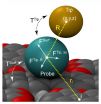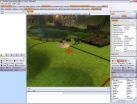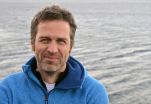Scanning tunneling microscopy: Computer simulations sharpen insights into molecules
2014-12-01
(Press-News.org) This news release is available in German.
Jülich, 27 November 2014 - The resolution of scanning tunnelling microscopes can be improved dramatically by attaching small molecules or atoms to their tip. The resulting images were the first to show the geometric structure of molecules and have generated a lot of interest among scientists over the last few years. Scientists from Forschungszentrum Jülich and the Academy of Sciences of the Czech Republic in Prague have now used computer simulations to gain deeper insights into the physics of these new imaging techniques. One of these techniques was presented in the journal Science by American scientists this spring. The results have now been published in the journal Physical Review Letters.
"A comparison between the experimental results and our simulations shows excellent agreement and that, therefore, our theoretical model is able to explain the mechanism behind the microscopic images in this family of techniques," says Prof. Tautz from Forschungszentrum Jülich. "This comparison is essential for analysing the images."
Together with his colleagues from the Peter Grünberg Institute (PGI-3), in 2008 Tautz introduced the method of attaching single molecules - initially hydrogen molecules, later molecules such as carbon monoxide - to the tip of a scanning tunnelling microscope and using them as extremely sensitive measuring probes. The scientific community responded with great interest to this method, and the technique has since been continuously refined. It enables scanning tunnelling microscopes to be used as a kind of atomic force microscope that is able to image the geometric structure of molecules with unprecedented accuracy.
"The valence charge clouds of complex organic molecules often spread over the entire molecule, thus concealing its atomic structure," says Tautz. Flexibly bound molecules at the microscope tip can be utilized as tailor-made sensors and signal transducers that are able to make the atomic structure visible nevertheless.
In the last few years, such atomic sensors have also proven useful for work with atomic force microscopes. Then, in May 2014, scientists from the University of California, Irvine, showed for the first time that these sensors can also be used to improve signals in a related imaging mode known as inelastic electron tunnelling spectroscopy. In this case, it is the vibration of the sensor molecule against the microscope tip that reacts sensitively to the surface potential of the scanned sample.
"Our calculations show the effect of the electrostatic forces on the high-resolution AFM, STM, and IETS images", explains Dr. Pavel Jelínek from the Institute of Physics at the Academy of Sciences of the Czech Republic in Prague. "We believe that the results of this work are an important contribution to the use of inelastic electron tunnelling spectroscopy that will allow the technique to be used as an additional source of information in materials science and to derive additional parameters from the images."
INFORMATION:
[Attachments] See images for this press release:


ELSE PRESS RELEASES FROM THIS DATE:
2014-12-01
This news release is available in German.
Genome engineering with the RNA-guided CRISPR-Cas9 system in animals and plants is changing biology. It is easier to use and more efficient than other genetic engineering tools, thus it is already being applied in laboratories all over the world just a few years after its discovery. This rapid adoption and the history of the system are the core topics of a review published in the renowned journal Science. The review was written by the discoverers of the system Prof. Emmanuelle Charpentier, who works at the Helmholtz Centre ...
2014-12-01
Teenage boys are perhaps more known for playing computer games but girls are better at making them, a University of Sussex study has found.
Researchers in the University's Informatics department asked pupils at a secondary school to design and program their own computer game using a new visual programming language that shows pupils the computer programs they have written in plain English.
Dr Kate Howland and Dr Judith Good found that the girls in the classroom wrote more complex programs in their games than the boys and also learnt more about coding compared to the ...
2014-12-01
"We have not seen an ice free period in the Arctic Ocean for 2,6 million years. However, we may see it in our lifetime." says marine geologist Jochen Knies. In an international collaborative project, Knies has studied the historic emergence of the ice in the Arctic Ocean. The results are published in Nature Communications.
The extent of sea ice cover in Arctic was much less than it is today between four and five million years ago. The maximum winter extent did not reaching its current location until around 2.6 million years ago. This new knowledge can now be used to ...
2014-12-01
This news release is available in German. FRANKFURT The chances of patients with Philadelphia chromosome-positive leukaemia (Ph+) being cured has greatly increased in recent years. Nevertheless, a high percentage of patients have developed resistance to available medication. But now, haematologists from Frankfurt, working with a Russian pharmaceutical company, have developed a new active substance that effectively combats the most aggressive forms of Philadelphia chromosome-positive leukaemia, both in vitro and in vivo. They have reported this in the current edition ...
2014-12-01
Tropical Depression 21W crossed the Philippines and moved into the South China Sea where warm waters helped strengthen the storm into Tropical Storm Sinlaku. NASA's Aqua satellite passed over the storm and captured an image that showed it appeared elongated.
Despite the strengthening of Tropical Depression 21W into a tropical storm on Nov. 28, it appeared elongated from southwest to northeast on visible imagery taken by the Moderate Resolution Imaging Spectroradiometer (MODIS) instrument that flies aboard Aqua. The MODIS image also showed that the strongest thunderstorms ...
2014-12-01
NASA's Terra satellite passed over Tropical Cyclone 02S after it formed in the Southern Indian Ocean on Nov. 28. An image from Terra showed that the new tropical storm is close to Mauritius and Reunion Islands.
The Moderate Resolution Imaging Spectroradiometer or MODIS instrument aboard NASA's Terra satellite captured a visible image of newborn Tropical Cyclone 02S northeast of the islands of Mauritius and Reunion. The MODIS image showed that thunderstorms were mostly west of the low-level center of circulation and bands of thunderstorms were wrapping into the center. ...
2014-12-01
This news release is available in German. Humans don't like being alone, and their genes are no different. Together we are stronger, and the two versions of a gene - one from each parent - need each other. Scientists at the Max Planck Institute for Molecular Genetics in Berlin have analysed the genetic makeup of several hundred people and decoded the genetic information on the two sets of chromosomes separately. In this relatively small group alone they found millions of different gene forms. The results also show that genetic mutations do not occur randomly in the ...
2014-12-01
Two physicists from the University of Warwick have taken to the kitchen to explain the complexity surrounding what they say is one of the last big mysteries in polymer physics.
As a way of demonstrating the complicated shapes that ring-shaped polymers can adopt, the researchers have created a brand new type of ring-shaped pasta, dubbed "anelloni" (anello being the Italian word for "ring"), which they've exclusively unveiled in this month's Physics World.
With just 2 eggs and 200 g of plain flour, Davide Michieletto and Matthew S Turner have created large loops of pasta ...
2014-12-01
Peter Friedl, M.D., Ph.D., professor of genitourinary medical oncology at The University of Texas MD Anderson Cancer Center, has received one of Italy's top scientific awards for his work in imaging and cancer growth, metastasis and therapy response.
Friedl was named a recipient of the 13th annual City of Florence Prize in Molecular Sciences. Previous recipients include such scientific luminaries as AIDS research pioneer Robert C. Gallo. M.D., human genome sequencing expert J. Craig Venter, Ph.D., and Nobel laureates Robert Hubert, Ph.D. and Ada Yonath, Ph.D. Friedl received ...
2014-12-01
Replenishing the supply of a molecule that normally activates cannabinoid receptors in the brain could relieve mood and anxiety disorders and enable some people to quit using marijuana, a Vanderbilt University study suggests.
Cannabinoid receptors are normally activated by compounds in the brain called endocannabinoids, the most abundant of which is 2-AG. They also are "turned on" by the active ingredient in marijuana.
Sachin Patel, M.D., Ph.D., and his colleagues developed a genetically modified mouse with impaired ability to produce 2-AG in the brain. The mice exhibited ...
LAST 30 PRESS RELEASES:
[Press-News.org] Scanning tunneling microscopy: Computer simulations sharpen insights into molecules








